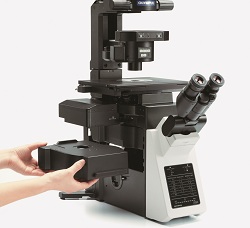OLYMPUS says its new range of inverted microscopes, the IX3 series, will be ‘future-proof’ thanks to their swappable deck modules. Aimed at the live cell imaging and clinical analysis markets, the three-model range each has at least one cartridge-like deck which can be removed and replaced easily, allowing a variety of optical components to be installed in the light path.
The entry-level IX53 has just a single swappable deck, but nevertheless offers fluorescent capabilities and is optimised for the routine examination of tissue samples. This microscope replaces the IX51, which Olympus candidly admits was not a big selling instrument. The new ‘scope may change the company’s fortunes here, due to its 8000 euro cost being roughly half that of the outgoing machine.
The mid-range IX73 can be configured in manual, semi-motorised, or motorised modes, and offers one or two swappable cartridge decks. These accept optical components such as magnification changers, filter turrets, or a right side port, and says the company will be useful when optical devices not yet thought of become available. This is the essence of the future-proof concept.
At the top of the range, the IX83 is a research grade microscope is fully motorised and includes a touch-panel interface and, like the IX73, is available in one- or two-deck designs. Each of the three instruments also benefits from a new closed frame structure, designed to increase the rigidity of the microscope chassis to improve the stability of images.
Olympus estimates the European life sciences microscope market to be worth about 354million euro annually, and is confident that this new range can help it secure a bigger slice of that pie. General manager of Olympus Europa, Gunnar Schroeder, spoke enthusiastically about the growing demand for this type of instrument due to the number of large-scale imaging centres currently being planned or built in universities and research parks across the continent.
“The growth in this market is at the top end”, he observed, estimating that about 100 high-specification fully motorised research micrscopes are sold in Europe each year. Olympus’s share is currently about 30 percent, he added, noting that these are expensive instruments (perhaps 200,000 euro) which customers rightly demanded deliver high performance. “Our modular deck system enables customers to protect their investment because it means that the instrument can accept applications not yet invented. This expandability is a revolution”.

